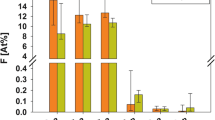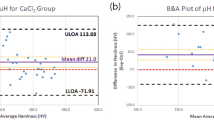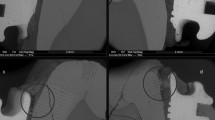Abstract
DESPITE numerous findings that intact enamel is permeable in certain circumstances to various dyes, radioactive tracers and other chemically identifiable substances1, the ionic-sieve behaviour of enamel demonstrated as long ago as 1929 by Klein and Amberson2 has been largely ignored. Their work could have an important bearing on the whole problem of ionic transport through enamel in vivo, and its chemical stability, so a more systematic study of membrane phenomena associated with enamel has been undertaken. The selectivity to ionic transport of enamel caps of sound human teeth, enamel sections and membranes prepared from a synthetic hydroxyapatite powrder in a poly (methyl methacrylate) matrix has been investigated by e.m.f. measurements of concentration cells using KCl, NaCl and CaCl2 solutions at pH. 7.4 and 25° ± 1° C. The technique for mounting the teeth and measuring the cell e.m.f. has been described in the literature3. The concentration of the electrolyte was maintained at 0.100 M on one side of the cell and on the other side varied in steps from 0.100 M to 0.002 M. All cell e.m.f.s were measured under equilibrium conditions as assessed by the constancy of the e.m.f. over a period of days. The establishment of equilibrium conditions on changing from one salt solution to another was protracted; following the replacement of CaCl2 solutions by KCl solutions, for example, the average time to re-establish equilibrium was of the order of 8 weeks.
This is a preview of subscription content, access via your institution
Access options
Subscribe to this journal
Receive 51 print issues and online access
$199.00 per year
only $3.90 per issue
Buy this article
- Purchase on Springer Link
- Instant access to full article PDF
Prices may be subject to local taxes which are calculated during checkout
Similar content being viewed by others
References
Jenkins, G. N., The Physiology of the Mouth (second ed.) (Blackwell Scientific Publications, Oxford, 1960).
Klein, H., and Amberson, W. R., J. Dent. Res., 9, 667 (1929).
Chick, A. O., and Waters, N. E., Arch. Oral Biol., 10, 1 (1965).
Leach, S. A., Arch. Oral Biol., 3, 48 (1960).
See Helfferich, F., Ion-Exchange (McGraw-Hill, 1962).
Neuman, W. F., and Neuman, M. W., The Chemical Dynamics of Bone Mineral (University of Chicago Press, Chicago, 1958).
Author information
Authors and Affiliations
Rights and permissions
About this article
Cite this article
WATERS, N. Electrochemical Properties of Human Dental Enamel. Nature 219, 62–63 (1968). https://doi.org/10.1038/219062b0
Received:
Issue Date:
DOI: https://doi.org/10.1038/219062b0
This article is cited by
Comments
By submitting a comment you agree to abide by our Terms and Community Guidelines. If you find something abusive or that does not comply with our terms or guidelines please flag it as inappropriate.



